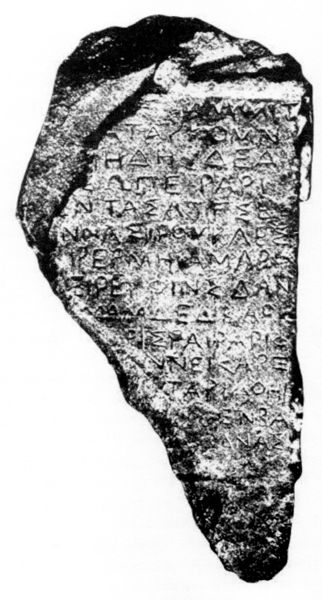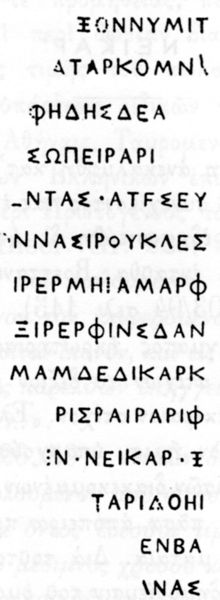Mother Komi- (Matar Komna/Μάταρ Κώμνα)
The proceedings of colonization.
It was found in 1904, in Praisos, Crete, Greece.
It dates back to the years after 400 B.C..

MOTHER KOMNA
Clear writing of the text on the rock.

An accurate copy of the inscription, taken from page 104 of the book Pelasgika (Πελασγικά), written by Iakovos Thomopoulos.
As the rock has been destroyed, only extracts of the text are available, thus, the conclusions we draw are very few.
This inscription was discovered in June 1904, during the excavations in the acropolis of Praisos, by Bosanguet. There were pieces of her left part found, so the whole text is not available. We can observe some innovations concerning the letters, on the right part, because its slate has been fully saved. We can find letters of the Ionian Alphabet, like H, Ω, and the digamma F, which cannot be found on older inscriptions. As half of the text is missing, we cannot interpret it in total. Instead, we can infer the content of the text by the words we have identified.
We identified some words in the actual text. We read them, we rendered them into Modern Greek, but we also approached them philosophically.
The language of the text is Greek, , typical of any Archaic Doric text. The grammatical structure of the text is mixed.
One can identify Pontic words, as well as Classical Greek Language.
The utterance of the words and of the verbal types, follows the grammatical rules of the Pontic and Doric Dialects, as well as those of the Classical Greek Language.
According to the study of the words that have been comprehended, we believe that the rock is probably a text of a colonization memory, in order to remind either of the homeland or relocation.
